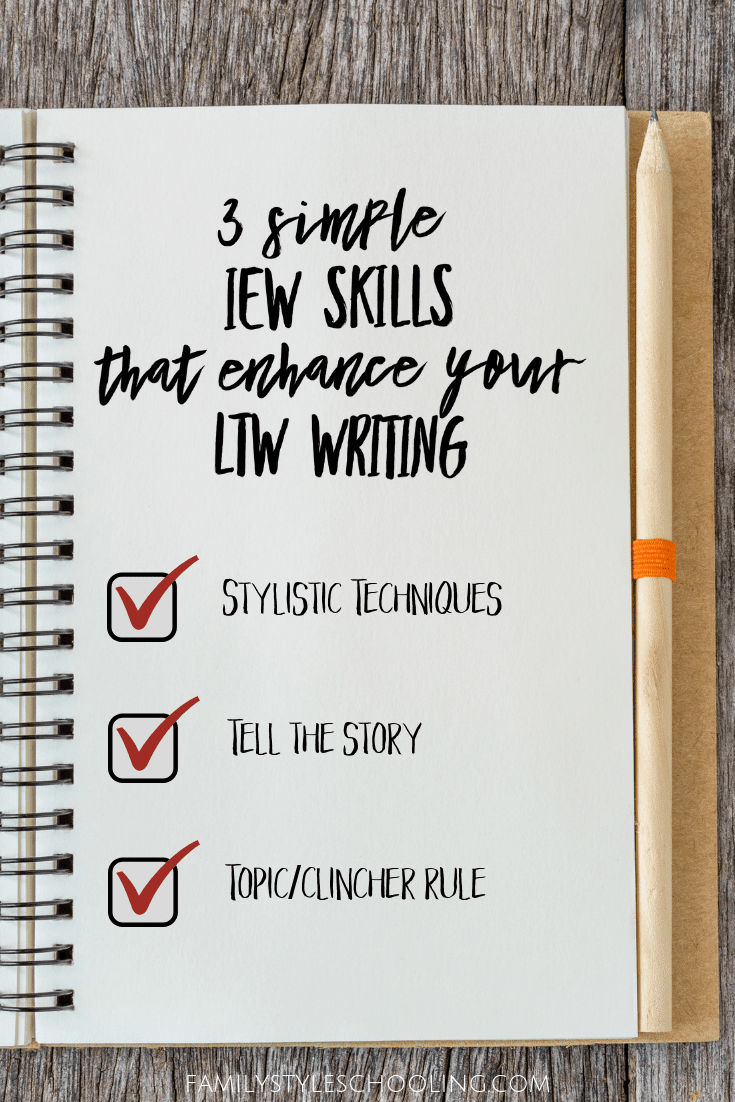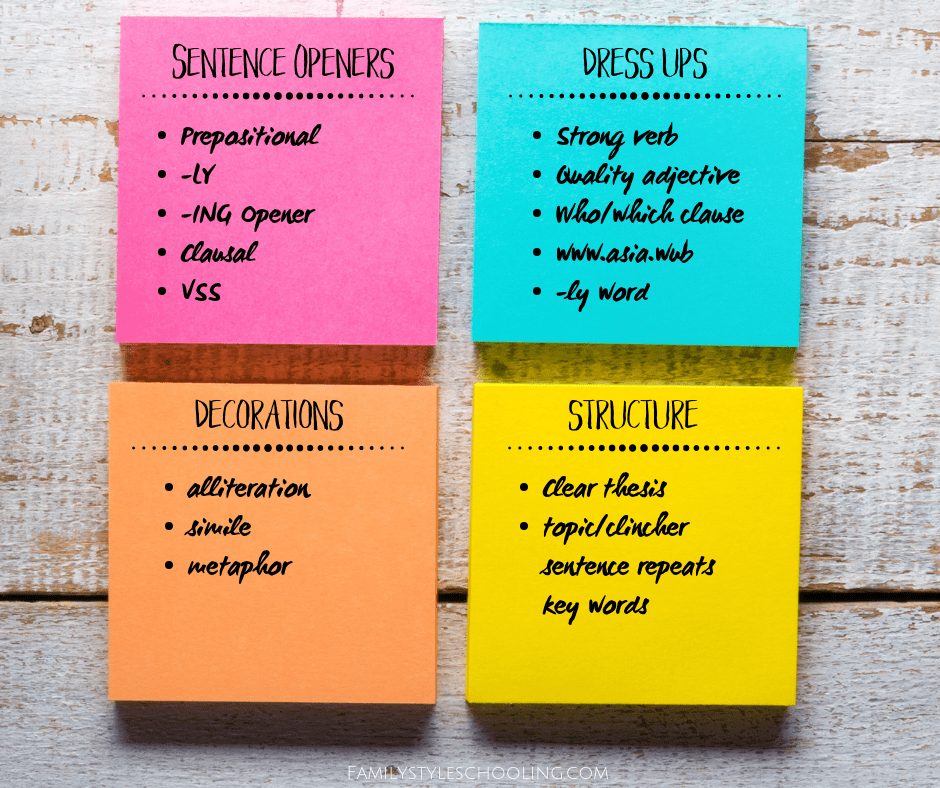3 Simple IEW Skills that Enhance Your LTW Writing
I am so grateful for Andrew Pudewa, author of the Institute for Excellence in Writing (IEW), and Andrew Kern, author of the Lost Tools of Writing (LTW). Both programs teach writing and complement one another so well. I've often heard people find wonderful success with IEW in elementary school, and then feel like their student's writing is going backwards when they start into LTW in middle school. The key is understanding the benefits of both in order to help your kids to connect their IEW writing skills to their LTW papers.

Strengths of IEW & LTW
My purpose isn't to really compare these two programs. They are both fantastic. Since they target different skills in writing, it's good to identify the strengths of both and look to see how you can line them up together to help your student strengthen their writing.
IEW Strengths:
When I first started homeschooling, IEW saved my relationship with my son! As a new homeschooler, I had some serious misconceptions about what my son should be able to come up with on his own. He struggled with coming up with ideas, and IEW saved us by offering sources to use as he learned to write. All of my kids have enjoyed learning to write with structure and style with IEW.
LTW Strengths:
As we moved into Challenge A and middle school writing, I loved that LTW offered tools for cultivating ideas of our own. Breaking the writing process down into the three main problems writers face, LTW builds specific skills of generating thoughts, arranging ideas, and expressing understanding. The persuasive essay provides a structure that can be used for debate as well.
Both of these writing programs are tools for teachers to use. If your student learned stylistic techniques from IEW, there is no reason they can't continue using them in their LTW writing. Here are three simple IEW skills that easily cross over into LTW writing.
1. Stylistic Checklists
My son's favorite part of IEW was using the stylistic checklists to check his writing at the end. Make a checklist for them like you do in IEW. How many sentence openers or dress-ups do you want in each paragraph?

Here's what happens when you don't ask for any of the IEW dress-ups or sentence openers. Let's look at this example.
The thesis for the argument is: Nat should have signed up to sail as the clerk on the Henry for three reasons: he acquired a good education, he received an easy job, and he became an excellent teacher. The outline for the first proof looks something like this:
- Nat acquired a good education
- he could bring his study books
- figured out lunars while sailing
- honorary degree at Harvard
When beginner students try to transfer this outline to paragraph form, it generally reads something like this:
The first reason Nat should have signed up to sail as the clerk on the Henry is that he acquired a good education. He could bring his study books. He figured out lunars while sailing. He earned an honorary degree at Harvard.
Done.
Sometimes, it's even rougher than that. I've seen students take their three sub proofs and combine them into one sentence with commas like this:
The first reason Nat should have signed up to sail as the clerk on the Henry is that he acquired a good education. He could bring his study books, figure out lunars, and earn an honorary degree at Harvard.
While they need to keep the first sentence of their paragraph uniform to fit the LTW structure, the sub proof section allows room for the sentence openers and dress-ups students learned in IEW. Here's what the paragraph could look like if just the sentence openers were varied:
The first reason Nat should have signed up to sail as the clerk on the Henry is that he acquired a good education. Fortunately, he could bring his study books. While sailing, he figured out lunars. In the end, he earned an honorary degree at Harvard.
Give them a checklist for how they could enhance each paragraph, and you'll see their writing improve substantially. At this point, there aren't enough sentences in each paragraph to require one of each of the sentence openers. Your checklist point can just be something like this:
- Paragraph does not contain two of the same sentence openers in a row.
They should start breaking away from the checklist as their writing skills improve. This just reminds them that they know how to improve a paragraph from something basic to something beautiful.
2. Tell the Story
The outline is bare bones for a reason. This gives the writer room to add some interest in their writing. Encourage your students to imagine writing out the evidence of their main proof to a person who doesn’t know the story (their audience). Fill in the gaps by asking those basic questions you learn in IEW Unit 7 - Writing from your brain: How? When? Where? Why? This helps them fluff up their explanations from the basic bullet point they wrote down on their ANI.

When you add in the details of the story, the paragraph grows a bit and can look something like this:
The first reason Nat should have signed up to sail as the clerk on the Henry is that he acquired a good education. Since Nat really loved to learn, Capitan Prince let him bring his study books during the long months at sea. When Nat would stand watch, he figured out a new way to solve lunars, which is finding your location based on the position of the moon and stars. Eventually he earned an honorary degree from Harvard.
You can really start to see this paragraph taking shape. I didn't even add that much more information, but it reads better and people who haven't read the book might be able to track with the ideas now.
3. Topic Clincher Rule
One of my favorite tools in IEW is the topic clincher rule. This concept helped me solidify my understanding on the purpose of a paragraph. When you start the paragraph with a topic sentence, you focus your paragraph on one idea. The clincher helps remind the reader of the topic after you've worked through your thoughts.
This works very well in LTW writing as well as it is a way to remind your reader/listener of the main proof at the end of that proof’s paragraph.
The first reason Nat should have signed up to sail as the clerk on the Henry is that he acquired a good education. Since Nat really loved to learn, Capitan Prince let him bring his study books during the long months at sea. When Nat would stand watch, he figured out a new way to solve lunars, which is finding your location based on the position of the moon and stars. Eventually he earned an honorary degree from Harvard because of all that he learned at sea.
Betsy Strauss is an unexpected homeschooler, mother of three, who is in a relationship with a sweet man for life. She loves reading books, drinking coffee, and learning anything with her kids.


I love this! Thank you!!!
Where can I get a checklist?
Because each student is so unique, I just make a checklist following Andrew Pudewa’s formula of easy + 1. What that means is I put things on their checklist that I know they know how to use, and then I add one thing to challenge them. Our checklist is generally scribbled on the side of the outline. It is not very formal but it does the trick!
exactly
Fabulous! Thank you 🙂
Thank you so much! This is a wonderful way to spice up the LTW essays and continue practicing the IEW skills. ❤️
You’re welcome!
This is very helpful thank you! I was sitting here with my son and his second essay thinking “essay 1 was very rudimentary but now what?” My son is miles ahead in his writing skills and I felt like LTW was dumbing it down for him- thanks for encouraging us to continue pressing forward with dressing up his writing.
I’m a student for challenge B I needed this Thank you